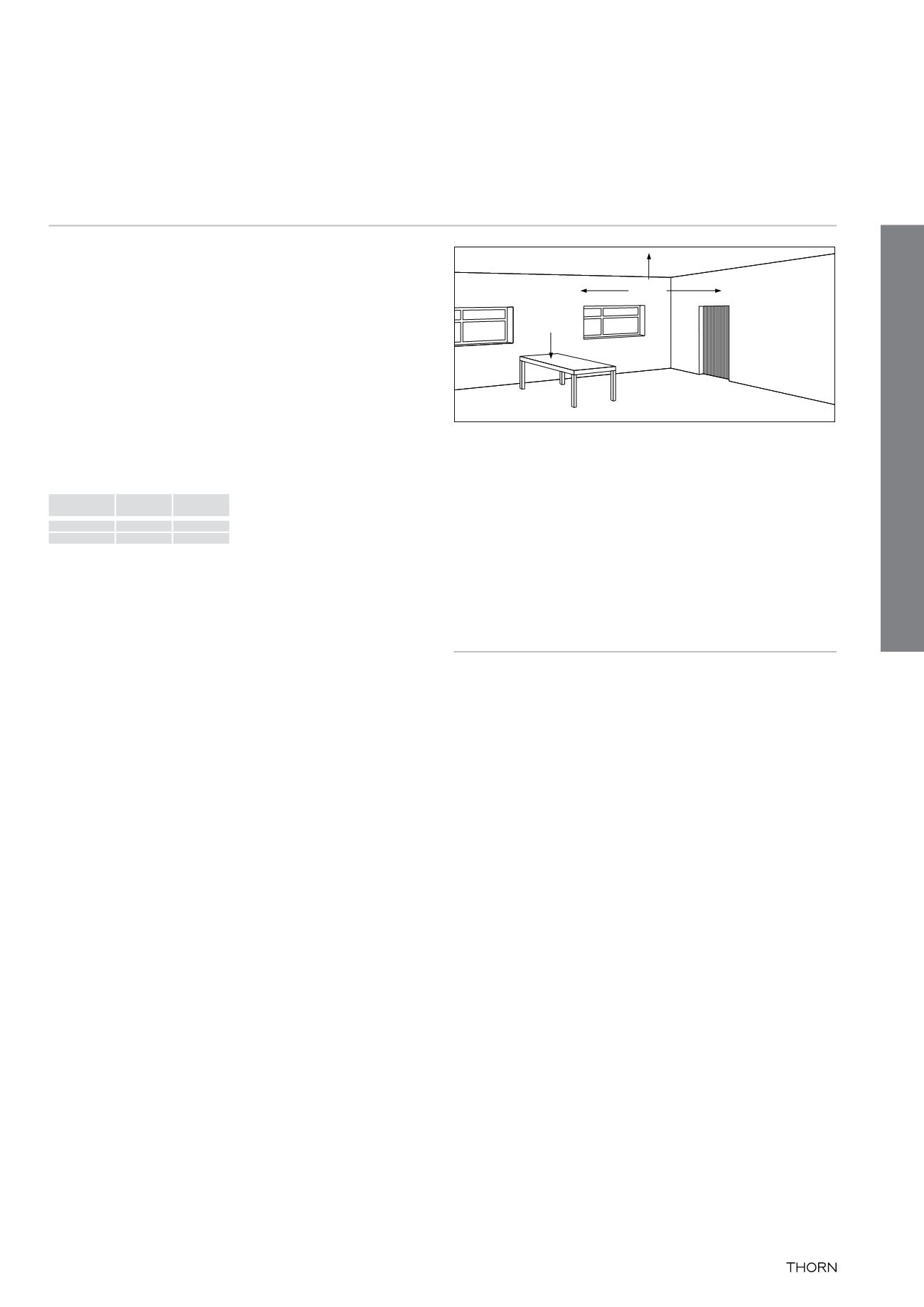

565
general information safety and quality www.thornlighting.co.ukLG7
SLL LG7 offers advice on all aspects of lighting design concerned with office
spaces and ancillary areas, and for areas using display screen equipment. An
addendum published in July 2012 harmonises the document with the requirements
in EN12464-1:2011. The document has two main criteria that have to be
addressed. The first is the decision that the designer has to take over the required
luminance limit of the optic to be used (all luminance limits are based on an
average value taken radially around the luminaire at an angle of 65°). The limits
for luminance relate to the type of screen and its anti-reflective treatment, together
with the software type in use. (See below).
Case A means Positive polarity software and normal requirements concerning
colour and detail, such as used in office, education etc.
Case B means negative polarity and/or higher requirements concerning colour
and detail, such as used for CAD colour inspection, etc.
Note: Screen high state luminance (see ISO 9241-302) describes the maximum
luminance of the white part of the screen and this value is available from the
manufacturer of the screen.
The second criteria concern the illuminance to the major surfaces within the room.
In all enclosed places the maintained illuminance on the major surfaces shall be:
Em > 50 lx with Uo >0.1 on the walls and
Em > 30 lx with Uo > 0.1 on the ceiling
It is recognised that in some applications such as racked storage, heavy industrial
premises, travel terminals, generally due to the size, complexity and operational
constraints the desired light levels on these surfaces may not be achievable. In
such cases reduced levels are acceptable. In some applications such as offices,
education, health care and general areas of entrance, corridors, stairs the walls
and ceiling need to be brighter to aid good communications. In these places it is
recommended that the maintained illuminance on the major surfaces should be:
Em > 75 lx with Uo > 0.1 on the walls and
Em > 50 lx with Uo > 0.1on the ceiling.
LG7 recognises that it is hard to achieve the luminance ratios mentioned above in
large open plan offices with low ceilings so it makes this statement:
“For the ceiling not to appear dark, the average illuminance on the ceiling, from
both the direct and reflected components, should be at least 30% of the average
horizontal illuminance across the working plane. In large spaces with ceilings
less than 2.4m high this may be hard to achieve. If there is no alternative to using
recessed luminaires, the ceiling illuminance ratio should still be as close to 30%
as possible. It is likely that where ceiling illuminance ratios are lower than 30% a
poor visual environment will result. Where reflected light is not sufficient to achieve
these levels, additional light from the sides of surface mounted downlights; from
uplighting elements of suspended luminaires; from dropped elements of recessed
downlights or from supplementary uplights may be needed“.
Copies of LG7 can be purchased on-line at
www.cibse.org/publicationsEffective reflectance of
walls between 0.3 and 0.7
Reflectance of floor cavity between 0.2 and 0.3
Relative wall
illuminance
0.5 to 0.8
Ceiling cavity reflectance
0.6 minimum
Relative ceiling
illuminance 0.3 to 0.9
Task illuminance 1.0
Lighting for people using Display Screen Equipment
Readers are referred to The Society of Light and Lighting’s (SLL) Lighting Guides 3
and 7 (LG3 & LG7), published in 1996 (an addendum was issued in 2001) and
2005 respectively and to EN12464-1:2011 which updates some elements of the
advice they contain.
Local Energy Legislation
The current version of Approved
Document L of the Building Regulations
for England and Wales, which
includes limits on the energy efficiency
of lighting in domestic and non-
domestic buildings, came into force
on October 1, 2010. The amended
documents have been published
and will come into force on 6th April
2014. Advice on compliance can be
obtained by Thorn offices.
Climate Change Legislation
Climate Change Levy (CCL) and
Enhanced Capital Allowances
(ECA). Having chosen the fiscal route
to encourage UK commerce and
industry to use less energy the UK
Government introduced the CCL on
all non-domestic energy use in April
2001. To enable businesses to claim
100% first year capital allowances
on investments in energy saving
equipment the ECA scheme was
introduced from 7 August 2001.
Businesses are now able to write off
the whole cost of their investment
against their taxable profit of the
period during which they make the
investment. Qualifying products
have to meet minimum performance
targets issued in August 2013. Thorn
can help with performance figures
for the majority of its luminaires, LED
luminaires and controls, which are
detailed on the company website.
Colour Rendering
The European Lighting Application
Standard EN 12464-1:2011 and new
SLL Lighting Code give design advice
concerning minimum colour rendering
index figures (Ra). Besides specific
Ra’s, recommended in the schedule
for various task types, all continuously
occupied spaces, that are used for
more than two hours, should employ
light sources with an Ra of not less than
80. An exception is made for high
bay applications where high pressure
sodium lamps are accepted.
Luminaires for Hazardous Areas
The Atex Directive is a mandatory requirement for all hazardous equipment sold
in the EU.
Atex Category 1 applies to areas where the risk of explosion is constantly present.
Atex Category 2 applies to areas where there is a risk of explosion during normal
operation of a building or plant.
Atex Category 3 applies to areas where there will only be occasional risk of
explosion and only during abnormal operation conditions.
Thorn offers product suitable for Category 2 or 3 areas.
Screen High
State Luminance >200cd/m
2
<200cd/m
2
Case A
3000cd/m
2
1500cd/m
2
Case B
1500cd/m
2
1000cd/m
2
Luminance limits for screen types:


















